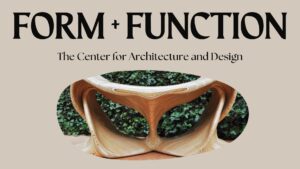
Waterfront Partnership’s Healthy Harbor Initiative has set a goal of a swimmable and fishable Inner Harbor. What could this look like? AIA Baltimore, the Baltimore Architecture Foundation and architecture journal T3XTURE organized a design competition in tandem with the Spring Lecture Series that invited multi-disciplinary teams of local architects, landscape architects, and planners to submit designs for projects that engage the harbor’s edge. Sustainability and resiliency were guiding principles of the competition, and teams had to address a variety of waterfront challenges including health and ecology, resiliency in the face of rising sea levels and powerful storms, and social equity.
Teams were given the following prompts:
(1) If the harbor becomes swimmable and fishable, what could the harbor edge look like?
(2) How can design enhance the connection between the city and harbor?
(3) What responsibility do we have to the harbor edge?
(4) How can we address spatial equity and create a harbor accessible to all residents of Baltimore?
(5) How can design solutions address resiliency in Baltimore, considering expanding flood plains and rising sea levels?
(6) What is the harbor edge in Baltimore? Should it be hard? Soft? Permeable?
(7) How can design address community engagement and education with harbor clean-up and pollution prevention?
(8) How can design at the harbor and city edge engage the public while respecting the natural environment?
Competition Entries
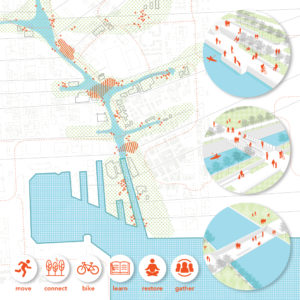 Stitch
Stitch
Team: CannonDesign
Ryan Jordan Pfarr, AIA; Monica Pascatore, AIA; Christina LoConte; Anthony Vischansky; Adam Louie, Assoc. AIA; Ryan Pietrowski, AIA
The current complexion of Baltimore’s harbor might suggest the addition of a singular structure(s) at its edge; to us it suggests something more. The harbor’s rich history is tied to both land and sea, natural and manmade systems, and to a diverse people dedicated to its past, present and future. This submission explores how edges can form a “whole” – it proposes that the harbor’s edge can be used as a means to stitch together neighborhoods that are otherwise disconnected.
 Permeable Futures
Permeable Futures
Team: Amanda Ganginis, AIA; Kelly Danz, AIA
Permeable Futures is a new harborscape centered on water and experience. Multiple new edge zone conditions foster a variety of interactions with the water, provide sea level rise and flood event resiliency, restore landscape and habitat, and create an urban waterfront park for residents and visitors. The project considers the history of land reclamation, oyster harvesting, and the industrial and maritime presence of the Baltimore Inner Harbor, studying the changing shoreline and historic piers that stretch into the water. The project proposes the inverse, allowing the water to stretch into the city and permeate with new slips and retention areas, reclaiming the waterline and creating multiple experiential edge zones with varying water levels.
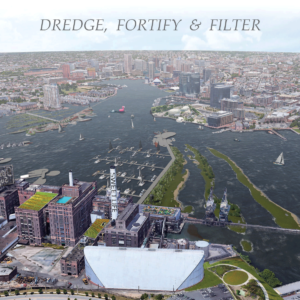 Harbor Reef: Revitalizing an Industrial Waterfront for Innovative Use
Harbor Reef: Revitalizing an Industrial Waterfront for Innovative Use
Team: Murphy & Dittenhafer Architects
Jonathan Taube, Assoc. AIA; Njillan Sarre, Assoc. AIA; Bryan Wright, Assoc. AIA; Kyle Giumento, Assoc. AIA
This project proposes a master plan to develop a more resilient waterfront that strengthens pedestrian connections, cultivates oyster reefs that filter pollutants from the Jones Falls River, and make innovative use of maintenance dredge to fortify the inlet to the Inner Harbor against storm surges. The reduction of flood risk increases recreational and aquaculture access to the waterfront and bridges the economic investment in the Harbor to surrounding neighborhoods
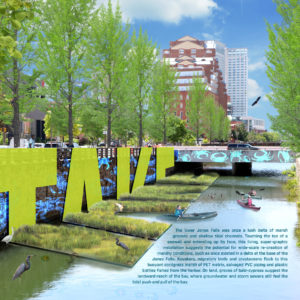 Take Back the Edge
Take Back the Edge
Team: Jonathan Ceci Landscape Architects
Jamie Barnett (Graphic Design); Jonathan Ceci, ASLA + Matthew Johnson, Assoc. ASLA (Landscape Architecture)
In order to make visible and inspire renewal of a widened natural edge, we propose a series of discrete interventions around the harbor on land and in water. Combining environmental graphics and living systems, these pop-up parks combine everyday materials in unexpected ways: dumpsters, chain link, plastic bottles, rusting posts and patched asphalt. These materials, so ubiquitous along the water’s edge, will be reassembled to represent abstractly the ecologies and experiences that have been lost and which might yet be reclaimed as the natural heritage of every Baltimorean.
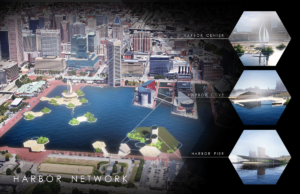 The Harbor Network
The Harbor Network
Team: CRGA Design
Lee Driskill, AIA; Juan Cardenas; Sarah Gilloran; Adam Brott; Laura Huacuja; Adam Rose; Kathryn Lam; Yoeldi Irizarry
The Harbor Network serves a dual purpose by providing Baltimore with a variety of activities and landmarks with which to interact, while also filtering the water through natural, sustainable means so the Inner Harbor – and Baltimore itself – can thrive. The Harbor Network is comprised of three fixed components – Harbor Center, Harbor Cove, and Harbor Pier – and several smaller mobile modules that connect to act as a kit of parts.
 The Interactive Edge
The Interactive Edge
Team: University of Maryland Landscape Architecture
Kevin Baker, Michael Pullano
“The Interactive Edge” transforms Baltimore’s Inner Harbor into a resilient place that redefines people’s connection with the water, creates habitat for wildlife, and improves water quality. The design team renews three significant sites: Rash Beach, McKeldin Park, and the Jones Falls Wetland Walk. Each provides a unique opportunity for interaction with the water.
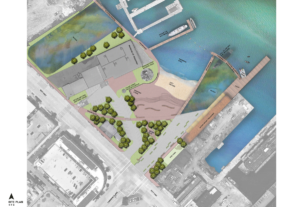 Untitled BMI Site Design
Untitled BMI Site Design
Team: Penza Bailey Architects
Paulina Beeche, AIA; Kim Wojcik, Assoc. AIA; Damssaul Dufrene, Assoc. AIA
The site adjacent to the Museum of Industry is underdeveloped but has potential to become a neighborhood gateway and destination, crossing the vehicular divide of Key Highway and extending the community to the water’s edge, encouraging access over the edge, through the edge, and beyond. Respecting existing exterior museum exhibits, this design weaves them into new interactive and connective program experiences and paths, enhancing visual and pedestrian access and creating a gathering place and edge thickness.
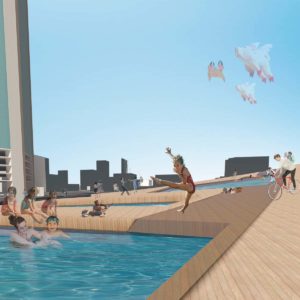
The Edge_H
Team: AECOM
Aaron Kelly, Assoc. AIA; Jisun Kwon
We propose that urban and climate stresses must be thought of as one-by thinking of the Harbor as a Social Ecosystem where ecology, people, infrastructure, and mobility work together as self-reinforcing systems. We developed a language for our new harbor intent: Relax, Active, and Connect. We took this idea of how nature has utilized lakes and rivers for centuries. Implementation of Ecological and social programs to connect the community and the people will strengthen the harbor as a resilient, a sustainable and a creative place to live, to visit, and to play.
 Pier 6 Resilience Center Master Plan
Pier 6 Resilience Center Master Plan
Team: Team Resilience
Stephanie Lynn Gerson, Assoc. AIA (Architectural Designer, slg Designs); Byrne Kelly, ASLA (Landscape Architect, The Greenfields Co.); Richard Wilke, RLA (Landscape Architect, Maryland Highway Administration); Chris Schoenster (Landscape Designer, MSU); Skyler Roberts, Assoc. AIA (architectural Designer, BCT Architects)
The Harbor’s Edge is hard, inflexible, and ill-prepared for sea level rise, storm surge, and flooding. Our vision is a protected edge that is flexible, adaptable, ecologically rich, and expands opportunities for all.
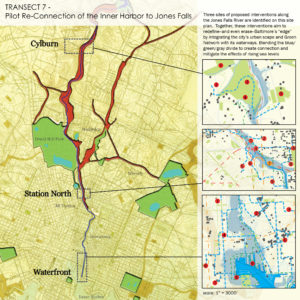 Transect 7 – Pilot Re-Connection of the Inner Harbor to Jones Falls River
Transect 7 – Pilot Re-Connection of the Inner Harbor to Jones Falls River
Team: Morgan State University
Faculty: Coleman Jordan; Samia Rab Kirchner, Intl. Assoc. AIA; Cristina Murphy; Archana Sharma | Students: Justin Fair; Jessica Freitas; Tranell Griffin; Avery Harmon; Naomi Wong Hemme; Ciera Jones; Tinashe Kasiyamhuru; Anthony Quivers; Colleen Sagers; Griffin Sanderoff
Rivers connect Land to Sea. Waterways do not have a “front” or a “back”; they simply flow from higher to lower ground in perpetuity. Water is perceived as an “edge” only when cities make it a barrier or a destination. Breaking with the brief’s presumption of waterfront being an edge, our project proposes three sites of pilot interventions along Jones Falls to stitch together the city’s cultural landmarks while maximizing the benefits of urban water environments. We believe that any change to Baltimore’s Harbor must start at a neighborhood level and propose three sites of connective interventions: Cylburn, Station North, and the Inner Harbor “Waterfront.”
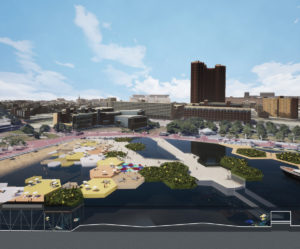 Links
Links
Team: CRDG
Richard Rinehart, AIA;Victoria Eckhardt
The goal of this proposal is to engage the community by providing an immersive experience: an underwater glass tunnel that connects the National Aquarium and the Maryland Science Center. Anchoring the tunnel, hexagonal elements are introduced as a response to the ever-evolving condition of a city, which might require elements to be added, removed or reconfigured. The easily manufacturable modular system can be 3D printed in an array of materials, such as locally sourced clay or recycled materials.
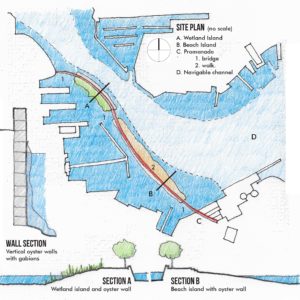 Blue Islands in the Baltimore Inner Harbor
Blue Islands in the Baltimore Inner Harbor
Team: The Drawing Board
Miriam Gusevich; Jay Kabriel; David Miles AIA; Peter Miles
Landscapes tell stories. The Inner Harbor is a constructed landscape for maritime use to welcome boats large and small, from close and far away. To tell the full story, the new islands reintroduce a token of the original shoreline with a beach, wetlands and oysters. The promenade linking the islands completes the existing harbor waterfront and provide pedestrian access to the water. An “S” curve frames the wetland island towards the marina and the beach island towards the navigable channel.
The Knollies
Team: APECx llc
Kenneth Michel, AIA
The submitted design re-imagines Baltimore’s Inner-City Harbor by redefining the historic lighthouse along the water’s edge and considers what the Harbor could look like if it were swimmable and fishable. Inspiration for the innovative structures or “Knollies” is derived from deconstructing the Seven Foot Knoll Lighthouse which currently resides in the south end of Pier 5 located in Baltimore’s Inner Harbor. The proposed scheme is based on a point grid system that enhances the intangible connection between the city and the Harbor by extending the city’s streets through the water’s edge. The grid provides a layout for the distribution of Knollies at 400 feet intervals. The grid’s intersections set up the scene for ‘event’ architecture that house activities such as concerts, art exhibitions, bathing, fishing, swimming, playing, dining, living, selling and working.

